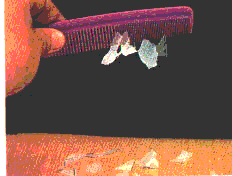
What is Static Electricity?
Everything is made up of atoms. Atoms have either a positive or negative charge depending on the number of protons or electrons that they have. Most matter is neutral, with an equal number of electrons and protons. Atoms with excess protons have a positive charge and atoms with excess electrons have a negative charge. Usually, atoms have the same number of electrons and protons. Then the atom has no charge, and it is "neutral." But if you rub things together, electrons can move from one atom to another. Some atoms gain extra electrons. They have a negative charge. Other atoms lose electrons. They have a positive charge. When charges are separated like this, it is called static electricity. Static electricity is the imbalance of charges between objects. A better definition for "static electricity" is high voltage. For example, when you rub your head on a balloon, you create up to 50,000 volts between the balloon and your hair. More specifically, "static" is high voltage at low (or zero) current.
If two things have different charges, they attract, or pull towards each other. If two things have the same charge, they repel, or push away from each other.

It is important to note that static electricity is not caused by friction. Friction caused by the rubbing only allows the electrons to move from thing to the other more easily. Friction is not necessary for this process of moving atoms to occur. An example is when you pull your hat off, it rubs against your hair. Electrons move from your hair to the hat. Now each of the hairs has the same positive charge. Things with the same charge repel each other. So the hairs try to move away from each other. The farthest they can get is to stand up and away from all the other hairs.


A similar effect is caused by rubbing a balloon on your head. Electrons from your hair jump from to the balloon, and it becomes negatively charged. Putting the balloon close to your hair pulls your hair out because they are opposites. This is static electricity.
Walking across carpet and rubbing your feet is another way to give yourself a negative charge. Notice you don't have to rub your feet, just the walking can cause the imbalance in electrons. You have created static electricity on yourself. Touch a door knob and ZAP! The electrons move from you to the knob. You get a shock.
One common misconception of static electricity is that it is electricity that is "static," or doesn't move. This is untrue. If given a good enough conductor and an imbalance of electrons, the static electricity can be expelled from the negatively charged item. This is the spark that we sometimes see, or the shock that we feel. The strength of the shock or spark depends on the difference in charge. The greater the difference in electrons, the more power the spark or shock has.
A weak shock is felt by rubbing your feet on the carpet and touching some type of metal.

A larger type of spark is lightning.

